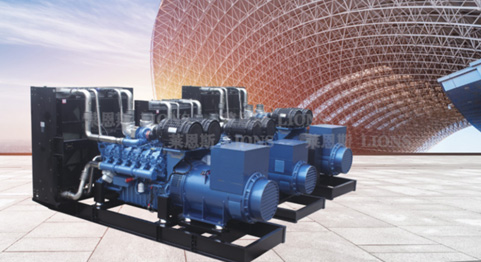Troubleshooting of generator
2021-12-17
1. Generator overheating
(1) The generator does not operate according to the specified technical conditions, such as excessive stator voltage and increased iron loss; If the load current is too large, the copper loss of stator winding increases;
The frequency is too low, which slows down the speed of the cooling fan and affects the heat dissipation of the generator; The power factor is too low, which increases the excitation current of the rotor and causes the rotor to heat. Check whether the indication of the monitoring instrument is normal. If it is abnormal, necessary adjustment and treatment shall be carried out to make the generator operate according to the specified technical conditions.
(2) The three-phase load current of the generator is unbalanced, and the overloaded one-phase winding will overheat;
If the difference of three-phase current exceeds 10% of the rated current, it belongs to serious cricket phase current imbalance. The three-phase current imbalance will produce negative sequence magnetic field, increase loss and cause heating of pole winding, ferrule and other parts. The three-phase load shall be adjusted to keep the current of each phase as balanced as possible.
(3) The air duct is blocked by dust accumulation and poor ventilation, resulting in difficulty in heat dissipation of the generator. Dust and oil dirt in the air duct shall be removed to make the air duct unobstructed.
(4) The air inlet temperature is too high or the water inlet temperature is too high, and the cooler is blocked. The inlet air or inlet water temperature shall be reduced and the blockage in the cooler shall be removed. Before troubleshooting, the generator load shall be limited to reduce the generator temperature.
(5) If too much or too little grease is added to the bearing, it shall be added according to the regulations, usually 1 / 2 ~ 1 / 3 of the bearing chamber (the upper limit for low speed and the lower limit for high speed), and it is appropriate not to exceed 70% of the bearing chamber.
(6) The bearing is worn. If the wear is not serious, the bearing will overheat locally; If the wear is serious, it may cause friction between the stator and rotor, resulting in overheating of the avoidance part of the stator and rotor. Check the bearing for noise. In case of stator and rotor friction, stop the machine immediately for maintenance or replace the bearing.
(7) The insulation of stator core is damaged, resulting in inter chip short circuit, resulting in the increase of local eddy current loss of iron core and heating, and the stator winding will be damaged in serious cases. Stop the machine immediately for maintenance.
(8) The parallel conductor of stator winding is broken, which increases the current of other conductors and generates heat. Stop the machine immediately for maintenance.
2. Abnormal voltage of generator neutral line to ground
(1) Under normal circumstances, the very low voltage caused by uneven air gap and unequal magnetic potential under each magnetic pole due to the influence of high-order harmonic or manufacturing process. If the voltage is one to several volts, there will be no danger and need not be treated.
(2) The generator winding has short circuit or poor insulation to the ground, which leads to the deterioration of the performance of electrical equipment and generator and easy heating. It shall be repaired in time to avoid the expansion of the accident.
(3) The neutral line has no voltage to the ground under no load, but the voltage under load is caused by three-phase imbalance. The three-phase load shall be adjusted to make it basically balanced.
3. Excessive engine current
(1) If the load is too large, reduce the load.
(2) In case of phase to phase short circuit or grounding fault of transmission line, the line shall be overhauled and can return to normal after troubleshooting.
4. Generator terminal voltage too high
(1) If the grid voltage of the generator in parallel with the grid is too high, the voltage of the generator in parallel shall be reduced.
(2) If over excitation is caused by the fault of excitation device, the excitation device shall be repaired in time.
5. Insufficient power
Due to the insufficient compound excitation compensation of the voltage source of the excitation device, it can not provide the excitation current required for armature reaction, so that the voltage at the generator terminal is lower than the grid voltage and can not send rated reactive power. The following measures shall be taken:
(1) A three-phase voltage regulator is connected between the generator and the excitation reactor to increase the generator terminal voltage and gradually increase the magnetic potential of the excitation device.
(2) Change the phase between the voltage magnetic flux potential of the excitation device and the voltage at the generator end to increase the synthetic total magnetic flux potential. A resistance of thousands of ohms and 10W can be connected in parallel at both ends of each phase winding of the reactor.
(3) Reduce the resistance of the rheostat to increase the excitation current of the generator.
6. Insulation breakdown and short circuit of stator winding
(1) The stator winding is damp. For generators that have been out of service for a long time or have been overhauled for a long time, the insulation resistance shall be measured before they are put into operation, and the unqualified ones shall not be put into operation. The damp generator shall be dried.
(2) Winding insulation breakdown or mechanical damage caused by winding defects or improper maintenance process. The insulating material shall be selected according to the specified insulation grade, and the embedded winding and paint dipping and drying shall be carried out in strict accordance with the process requirements.
(3) Winding overheating. Overheating of insulation will reduce the insulation performance, and sometimes it will quickly cause insulation breakdown at high temperature. Daily patrol inspection shall be strengthened to prevent overheating of all parts of the generator from damaging the winding insulation.
(4) Insulation aging. Generally, when the generator has been running for more than 15 ~ 20 years, its winding insulation is aging, electrical performance changes, and even insulation breakdown. The maintenance and preventive test of the generator shall be done well. If the insulation is found to be unqualified, the defective winding insulation or winding shall be replaced in time to prolong the service life of the generator.
(5) Metal foreign matters enter the generator. Do not leave metal objects, parts or tools in the stator chamber after the generator is serviced; Bind the binding line of the rotor and fasten the end parts to avoid loosening due to centrifugal force.
(6) Over voltage breakdown:
① The line is struck by lightning, and the lightning protection is not perfect. Lightning protection facilities shall be improved.
② Misoperation, such as raising the generator voltage too high when no-load. The generator shall be boosted in strict accordance with the operating procedures to prevent misoperation.
③ For Internal Overvoltage of generator, including operation overvoltage, arc grounding overvoltage and resonance overvoltage, preventive test of winding insulation shall be strengthened to find and eliminate defects in stator winding insulation in time.
7. Stator core relaxation
Due to improper manufacturing and assembly, the iron core is not fastened well. If the whole iron core is loose, for small generators, two iron plates smaller than the inner diameter of the end of the stator winding can be used, put on stud bolts and tighten the iron core. After the original shape is restored, tighten the original clamping bolts of the iron core. If the local iron core is loose, the silicon steel sheet paint can be painted between the loose sheets, and then the hard insulating material can be inserted into the loose part.
8. Short circuit between iron chips
(1) The core lamination is loose, and the insulation is damaged due to the vibration of the core when the generator is running; If the insulation of iron chip is damaged in some places or the iron core is overheated locally, so that the insulation is aged, it shall be treated according to the method in the original plan.
(2) There are burrs on the edge of iron chip or mechanical damage during maintenance. The burr shall be removed with a fine file, the damaged part shall be trimmed, the surface shall be cleaned, and then a layer of silicon steel sheet paint shall be applied.
(3) For short-circuit iron core with solder or copper particles, the metal fusion welding joint shall be scraped or chiseled, and the surface shall be treated.
(4) Arc short circuit of the winding may also cause short circuit of the iron core. The burned part shall be removed with a chisel and the surface shall be treated.
9. The generator loses residual magnetism and cannot generate electricity during starting
(1) Residual magnetism is often lost after shutdown because the material used for the magnetic pole of the exciter is close to mild steel and there is less residual magnetism. When there is no current in the excitation winding after shutdown, the magnetic field will disappear. A battery shall be prepared and magnetized before power generation.
(2) If the magnetic pole of the generator loses magnetism, a DC current greater than the rated current (for a short time) shall be introduced into the winding for magnetization, that is, sufficient residual magnetism can be restored.
10. The temperature of the excitation reactor of the automatic excitation device is too high
(1) If the reactor coil is short circuited locally, the reactor shall be repaired.
(2) If the air gap of the reactor magnetic circuit is too large, the air gap of the magnetic circuit shall be adjusted.
11. The voltage cannot rise after the generator is started
(1) The excitation circuit is disconnected, so that the voltage cannot rise. Check whether the excitation circuit is broken and whether the contact is good.
(2) The residual magnetism disappears. If there is no indication on the exciter voltmeter that the residual magnetism disappears, the exciter shall be magnetized.
(3) If the polarity of the field coil of the exciter is reversed, its positive and negative connecting wires shall be reversed.
(4) In some tests during generator maintenance, the magnetic field coil is wrongly energized with reverse DC, resulting in the disappearance or reverse of residual magnetism, so it shall be magnetized again.
(1) The generator does not operate according to the specified technical conditions, such as excessive stator voltage and increased iron loss; If the load current is too large, the copper loss of stator winding increases;
The frequency is too low, which slows down the speed of the cooling fan and affects the heat dissipation of the generator; The power factor is too low, which increases the excitation current of the rotor and causes the rotor to heat. Check whether the indication of the monitoring instrument is normal. If it is abnormal, necessary adjustment and treatment shall be carried out to make the generator operate according to the specified technical conditions.
(2) The three-phase load current of the generator is unbalanced, and the overloaded one-phase winding will overheat;
If the difference of three-phase current exceeds 10% of the rated current, it belongs to serious cricket phase current imbalance. The three-phase current imbalance will produce negative sequence magnetic field, increase loss and cause heating of pole winding, ferrule and other parts. The three-phase load shall be adjusted to keep the current of each phase as balanced as possible.
(3) The air duct is blocked by dust accumulation and poor ventilation, resulting in difficulty in heat dissipation of the generator. Dust and oil dirt in the air duct shall be removed to make the air duct unobstructed.
(4) The air inlet temperature is too high or the water inlet temperature is too high, and the cooler is blocked. The inlet air or inlet water temperature shall be reduced and the blockage in the cooler shall be removed. Before troubleshooting, the generator load shall be limited to reduce the generator temperature.
(5) If too much or too little grease is added to the bearing, it shall be added according to the regulations, usually 1 / 2 ~ 1 / 3 of the bearing chamber (the upper limit for low speed and the lower limit for high speed), and it is appropriate not to exceed 70% of the bearing chamber.
(6) The bearing is worn. If the wear is not serious, the bearing will overheat locally; If the wear is serious, it may cause friction between the stator and rotor, resulting in overheating of the avoidance part of the stator and rotor. Check the bearing for noise. In case of stator and rotor friction, stop the machine immediately for maintenance or replace the bearing.
(7) The insulation of stator core is damaged, resulting in inter chip short circuit, resulting in the increase of local eddy current loss of iron core and heating, and the stator winding will be damaged in serious cases. Stop the machine immediately for maintenance.
(8) The parallel conductor of stator winding is broken, which increases the current of other conductors and generates heat. Stop the machine immediately for maintenance.
2. Abnormal voltage of generator neutral line to ground
(1) Under normal circumstances, the very low voltage caused by uneven air gap and unequal magnetic potential under each magnetic pole due to the influence of high-order harmonic or manufacturing process. If the voltage is one to several volts, there will be no danger and need not be treated.
(2) The generator winding has short circuit or poor insulation to the ground, which leads to the deterioration of the performance of electrical equipment and generator and easy heating. It shall be repaired in time to avoid the expansion of the accident.
(3) The neutral line has no voltage to the ground under no load, but the voltage under load is caused by three-phase imbalance. The three-phase load shall be adjusted to make it basically balanced.
3. Excessive engine current
(1) If the load is too large, reduce the load.
(2) In case of phase to phase short circuit or grounding fault of transmission line, the line shall be overhauled and can return to normal after troubleshooting.
4. Generator terminal voltage too high
(1) If the grid voltage of the generator in parallel with the grid is too high, the voltage of the generator in parallel shall be reduced.
(2) If over excitation is caused by the fault of excitation device, the excitation device shall be repaired in time.
5. Insufficient power
Due to the insufficient compound excitation compensation of the voltage source of the excitation device, it can not provide the excitation current required for armature reaction, so that the voltage at the generator terminal is lower than the grid voltage and can not send rated reactive power. The following measures shall be taken:
(1) A three-phase voltage regulator is connected between the generator and the excitation reactor to increase the generator terminal voltage and gradually increase the magnetic potential of the excitation device.
(2) Change the phase between the voltage magnetic flux potential of the excitation device and the voltage at the generator end to increase the synthetic total magnetic flux potential. A resistance of thousands of ohms and 10W can be connected in parallel at both ends of each phase winding of the reactor.
(3) Reduce the resistance of the rheostat to increase the excitation current of the generator.
6. Insulation breakdown and short circuit of stator winding
(1) The stator winding is damp. For generators that have been out of service for a long time or have been overhauled for a long time, the insulation resistance shall be measured before they are put into operation, and the unqualified ones shall not be put into operation. The damp generator shall be dried.
(2) Winding insulation breakdown or mechanical damage caused by winding defects or improper maintenance process. The insulating material shall be selected according to the specified insulation grade, and the embedded winding and paint dipping and drying shall be carried out in strict accordance with the process requirements.
(3) Winding overheating. Overheating of insulation will reduce the insulation performance, and sometimes it will quickly cause insulation breakdown at high temperature. Daily patrol inspection shall be strengthened to prevent overheating of all parts of the generator from damaging the winding insulation.
(4) Insulation aging. Generally, when the generator has been running for more than 15 ~ 20 years, its winding insulation is aging, electrical performance changes, and even insulation breakdown. The maintenance and preventive test of the generator shall be done well. If the insulation is found to be unqualified, the defective winding insulation or winding shall be replaced in time to prolong the service life of the generator.
(5) Metal foreign matters enter the generator. Do not leave metal objects, parts or tools in the stator chamber after the generator is serviced; Bind the binding line of the rotor and fasten the end parts to avoid loosening due to centrifugal force.
(6) Over voltage breakdown:
① The line is struck by lightning, and the lightning protection is not perfect. Lightning protection facilities shall be improved.
② Misoperation, such as raising the generator voltage too high when no-load. The generator shall be boosted in strict accordance with the operating procedures to prevent misoperation.
③ For Internal Overvoltage of generator, including operation overvoltage, arc grounding overvoltage and resonance overvoltage, preventive test of winding insulation shall be strengthened to find and eliminate defects in stator winding insulation in time.
7. Stator core relaxation
Due to improper manufacturing and assembly, the iron core is not fastened well. If the whole iron core is loose, for small generators, two iron plates smaller than the inner diameter of the end of the stator winding can be used, put on stud bolts and tighten the iron core. After the original shape is restored, tighten the original clamping bolts of the iron core. If the local iron core is loose, the silicon steel sheet paint can be painted between the loose sheets, and then the hard insulating material can be inserted into the loose part.
8. Short circuit between iron chips
(1) The core lamination is loose, and the insulation is damaged due to the vibration of the core when the generator is running; If the insulation of iron chip is damaged in some places or the iron core is overheated locally, so that the insulation is aged, it shall be treated according to the method in the original plan.
(2) There are burrs on the edge of iron chip or mechanical damage during maintenance. The burr shall be removed with a fine file, the damaged part shall be trimmed, the surface shall be cleaned, and then a layer of silicon steel sheet paint shall be applied.
(3) For short-circuit iron core with solder or copper particles, the metal fusion welding joint shall be scraped or chiseled, and the surface shall be treated.
(4) Arc short circuit of the winding may also cause short circuit of the iron core. The burned part shall be removed with a chisel and the surface shall be treated.
9. The generator loses residual magnetism and cannot generate electricity during starting
(1) Residual magnetism is often lost after shutdown because the material used for the magnetic pole of the exciter is close to mild steel and there is less residual magnetism. When there is no current in the excitation winding after shutdown, the magnetic field will disappear. A battery shall be prepared and magnetized before power generation.
(2) If the magnetic pole of the generator loses magnetism, a DC current greater than the rated current (for a short time) shall be introduced into the winding for magnetization, that is, sufficient residual magnetism can be restored.
10. The temperature of the excitation reactor of the automatic excitation device is too high
(1) If the reactor coil is short circuited locally, the reactor shall be repaired.
(2) If the air gap of the reactor magnetic circuit is too large, the air gap of the magnetic circuit shall be adjusted.
11. The voltage cannot rise after the generator is started
(1) The excitation circuit is disconnected, so that the voltage cannot rise. Check whether the excitation circuit is broken and whether the contact is good.
(2) The residual magnetism disappears. If there is no indication on the exciter voltmeter that the residual magnetism disappears, the exciter shall be magnetized.
(3) If the polarity of the field coil of the exciter is reversed, its positive and negative connecting wires shall be reversed.
(4) In some tests during generator maintenance, the magnetic field coil is wrongly energized with reverse DC, resulting in the disappearance or reverse of residual magnetism, so it shall be magnetized again.










